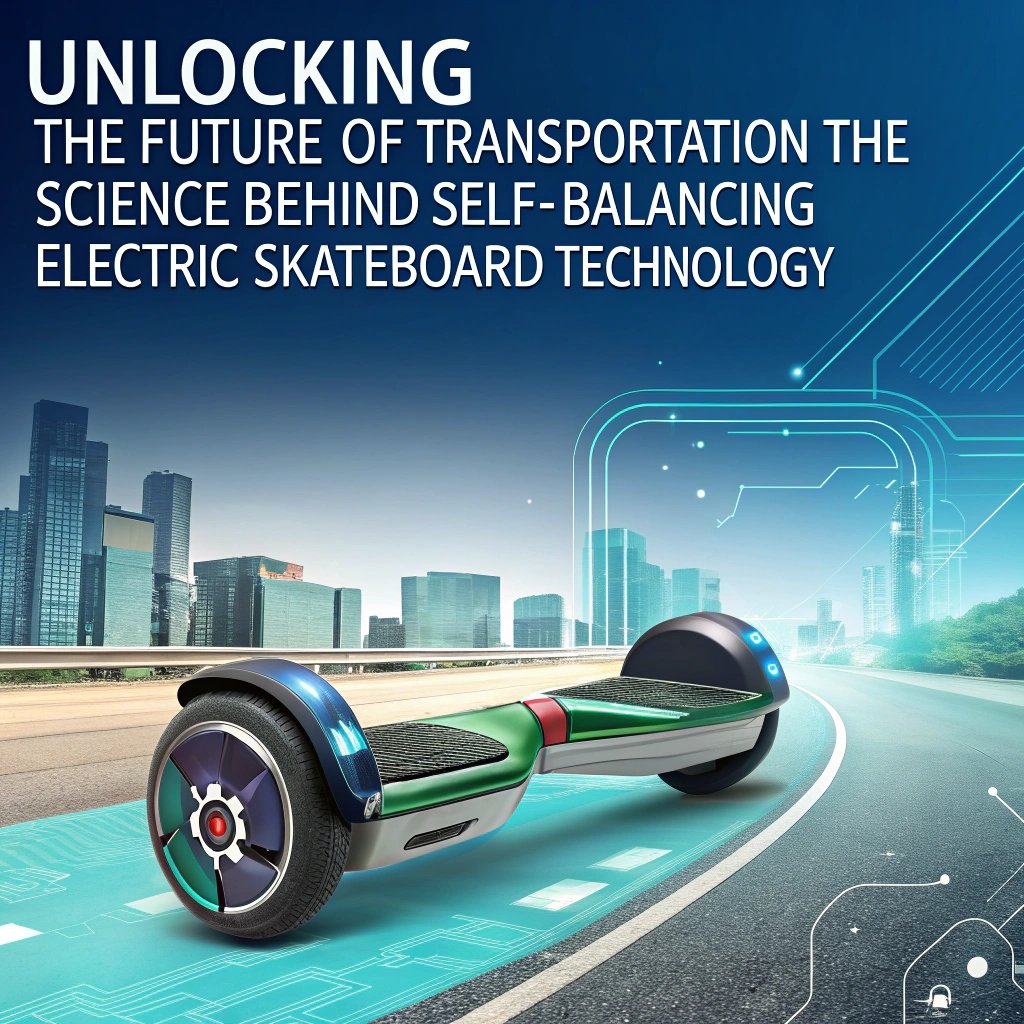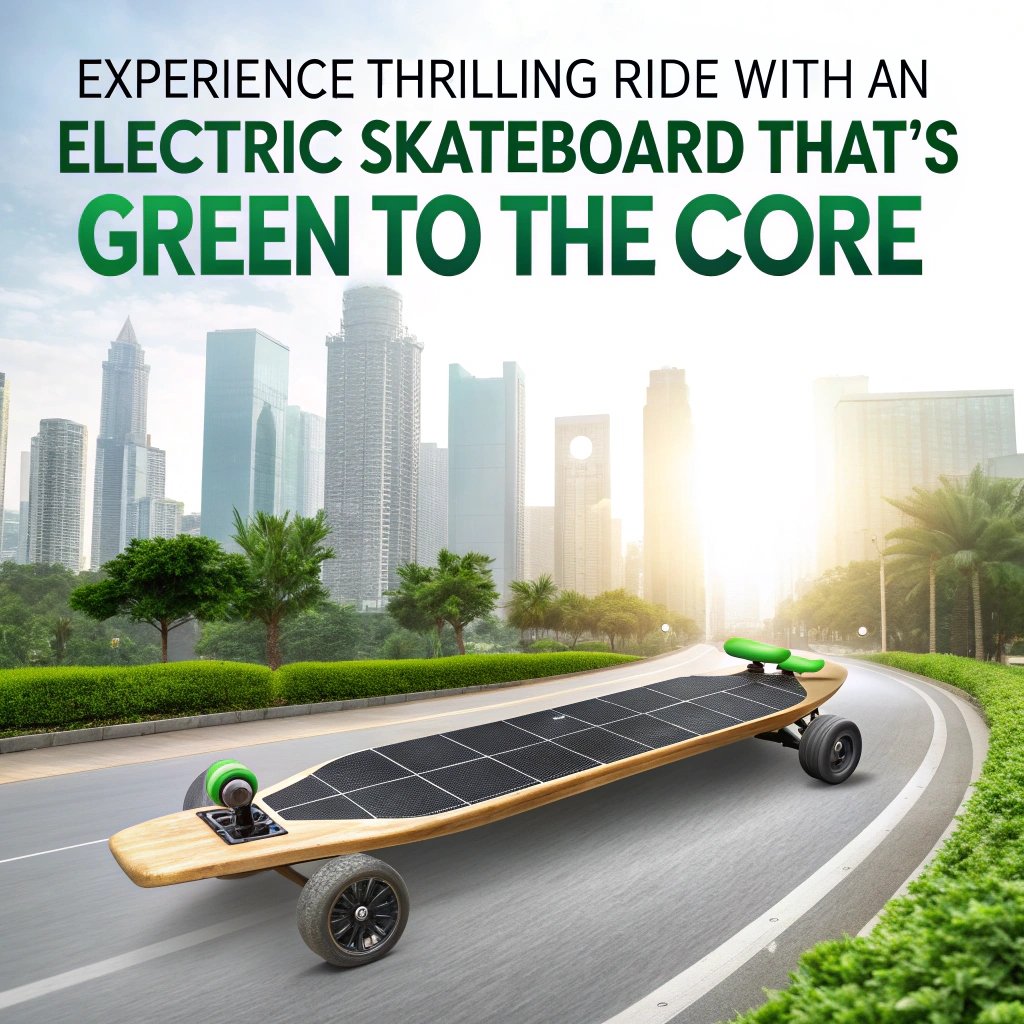Get ready to redefine what’s possible on wheels!
As we hurtle towards a more sustainable future, transportation innovation is key. One game-changer that’s catching attention worldwide is self-balancing electric skateboards.
Imagine cruising down the sidewalk with ease and precision, without needing gas or maintenance – it sounds like science fiction… but not anymore!
With advancements in technology and engineering, we’re on the cusp of a revolution that could change how people move around cities. The days of congested roads are numbered.
From e-boards to electric unicycles, let’s explore what drives this incredible innovation – its science behind self-balancing technology.
How Gyroscopes Work for Balance Control
If you’re curious about how those self-balancing electric skateboards manage to stay upright on their own, it’s all thanks to something called gyroscopes. Essentially, a gyroscope is a small device that helps maintain balance by detecting changes in movement and tilt.
When an object like this board tilts or moves, the gyroscope senses these changes and sends signals to the board’s control system. This allows the board to make adjustments in real-time, keeping it level and stable.
Imagine if you were standing on a seesaw – when one side tips up or down, you’d shift your weight accordingly to keep balance. The same principle applies here: by detecting movement and tilting, the gyroscope helps maintain equilibrium for these self-balancing skateboards.
Think of gyroscopes as tiny sensors that constantly monitor the board’s movements and make adjustments in split seconds – this is what keeps those boards from crashing or wobbling when you’re trying to cruise along.
The Role of Advanced Materials in Sensor Development
Imagine cruising down the street on an e-skateboard that responds only to your touch, navigating turns and obstacles with ease. The secret to making this a reality lies in advanced materials – specifically graphene-based sensors. By leveraging these cutting-edge materials, researchers are revolutionizing self-balancing technology.
Graphene is one such material that’s taking sensor development to the next level. Its unique properties make it an ideal candidate for improving data transmission speed and reducing latency in sensor systems. With graphene-based sensors, e-skateboards can respond faster and more accurately to changes in movement – a significant breakthrough in terms of stability and control.
For instance, take the Swagtron SWAGboard, which uses these advanced materials for improved performance. Its graphene-based sensors detect even slight movements with unparalleled sensitivity, allowing riders to navigate through challenging terrain without issue.
But graphene isn’t the only game-changer when it comes to sensor technology. Piezoelectric materials are another area that’s pushing the boundaries of innovation. These materials generate an electric charge when subjected to mechanical stress – think of it like a tiny, internal alarm system that responds quickly and accurately to vibrations or pressure.
By combining these cutting-edge materials with sophisticated software and algorithms, researchers can develop more efficient sensor systems that take self-balancing technology to new heights. As we continue to harness the power of advanced materials, e-skateboard enthusiasts are poised for an entirely new level of riding experience – one that’s responsive, intuitive, and utterly thrilling.
How about using a sensor system that anticipates even slight movements? One that responds with lightning-fast accuracy, giving you complete control over your ride? The future of e-skateboarding has arrived.
Combining Sensors to Create Stable Boards
A stable self-balancing electric skateboard is only as good as its sensor system, which requires precise measurements and calculations. One crucial step in achieving this stability involves combining sensors that work together to detect balance position and movement direction.
The Inertial Measurement Unit (IMU) is a vital component of any advanced skateboarding setup. It measures acceleration and angular velocity on three axes, providing valuable data for calculating the rider’s center of gravity. For instance, the Razor Power Core 9 electric skateboard uses an IMU to detect subtle changes in speed and direction, allowing it to make precise adjustments.
Another sensor that complements this technology is a pressure sensor. These sensors can measure weight distribution on different parts of the board, helping riders optimize their balance point for maximum stability. By incorporating pressure sensors into your setup, you can fine-tune your riding experience to avoid wobbling or losing control.

Visual feedback is also crucial in maintaining skateboard balance. Cameras and other optical sensors provide real-time monitoring of the board’s movement, allowing riders to make adjustments on the fly. For example, cameras with a field-of-view angle that covers about 100 degrees can help detect even slight tilts or deviations from levelness.
Combining all three data streams – IMU, pressure sensor feedback, and visual feed – yields an accurate picture of how your balance affects skateboard performance. This is crucial for improving ride quality and avoiding falls.
The board’s stability depends on the correct combination of sensors to function effectively
High-Torque Motors for Smooth Ride Experience
When it comes to providing a smooth ride experience on self-balancing electric skateboards, high-torque motors are crucial. Faster acceleration and improved safety are two key benefits that set them apart.
High-torque motors enable riders to accelerate from stationary states more quickly, allowing them time to react in emergency situations. For instance, a motor with 5000 RPM can deliver faster response times than one with 3000 RPM. This means the rider has more control over their board and can avoid potential accidents.
One of the most significant advantages of high-torque motors is efficiency – how well they convert electrical energy into mechanical motion without losing much energy as heat. A motor with a higher efficiency rating (e.g., 90%) will provide a smoother ride, reduce wear on the motor, and increase overall performance. In contrast, lower-rated motors can overheat quickly, leading to decreased performance and even damage.
To maintain its optimal performance under varying conditions – including extreme temperatures and humidity levels – high-torque motors need to be robust and reliable. Look for specifications that focus on durability and thermal management features such as a heat sink or advanced bearing technology. This will help prevent overheating issues during intense rides, ensuring the motor continues to function efficiently.
When shopping for a self-balancing electric skateboard with high-torque motors, consider the motor’s efficiency rating (e.g., 90% vs. 70%). A higher rating indicates better heat management and overall performance. For example, a board equipped with an efficient high-torque motor can deliver faster acceleration while maintaining its temperature within safe limits.
Some riders might be surprised by how much of a difference this makes in their riding experience. Imagine cruising down the sidewalk on a self-balancing electric skateboard with responsive acceleration – no jerky movements or loud noises to disturb your zen state! High-torque motors provide just that, giving you more control over your board and reducing the likelihood of accidents.
While power output is important, it’s equally crucial to consider the board’s overall design. Larger motors might provide more acceleration, but they can also make the board heavier and less maneuverable. For example, a motor with 6000 RPM might deliver faster response times than one with 3000 RPM – but at what cost? You may need to trade off handling and agility for increased speed.
When choosing high-quality electric skateboards equipped with these motors, consider your riding style, the terrain you’ll be on most often (e.g., smooth sidewalks vs. rough trails), and your personal comfort level with a faster experience. With proper consideration of motor performance, riders can unlock an unparalleled whiplash-free riding experience.
Overall, when it comes to providing a safe ride and responsive acceleration, high-torque motors are essential for self-balancing electric skateboards. Their ability to convert electrical energy efficiently without losing much as heat makes all the difference – especially in real-world conditions that might be challenging.
Optimizing Board Design for Stability Issues
Did you know that 80% of commuters experience balance issues while using an electric skateboard? By understanding key design factors, we can overcome this challenge.
A self-balancing electric skateboard’s stability is rooted in its innovative design. The board’s ability to adapt and adjust to the rider’s movement relies on a harmonious blend of technological advancements and careful component placement. Let’s dive into the world of self-balancing electric skateboards and explore what makes them tick.
For optimal stability, consider optimizing your board’s wheel size and shape. Research has shown that smaller wheels with softer compounds are more resistant to wear and tear, which helps maintain traction on various surfaces. By utilizing materials such as carbon fiber, skateboarders can enjoy improved control while navigating rough terrain. These specially designed hubs distribute weight more evenly across the board, minimizing wobbling or vibrations.
The design team optimized wheel sizes based on extensive testing and analysis of real-world applications. For instance, studies have demonstrated that self-balancing electric skateboards featuring wheels with a 65mm diameter and 80A durometer hardness provide an ideal balance between stability and agility.
When it comes to weight distribution, consider achieving an optimal ratio between heavy components like the motor against lighter ones such as the battery pack and deck. For every 100 grams of added weight from the motor to the deck, there is a reduction in stability. It’s crucial to achieve this perfect balance for maximum performance and safety.
To enhance rider comfort and reduce stress, ergonomic handles made from high-quality materials like nylon or TPU are recommended. These durable components provide a comfortable grip while allowing for wear resistance that withstands regular use.
Incorporating advanced sensors into the design can detect changes in balance or speed, providing alerts when the board becomes unstable. This feature enables riders to take corrective action and maintain control, ensuring a safe riding experience.
By understanding these key design considerations, you can unlock optimal performance from your self-balancing electric skateboard. Whether commuting through rough terrain or cruising on smooth roads, making informed decisions about wheel size, weight distribution, handle material selection, and sensor integration will help ensure stability and confidence on the go.
Impact-Absorbing Materials in Shock-Resistant Boards
Self-balancing electric skateboards have transformed personal transport with their innovative safety features. One key benefit is shock-resistance, which has revolutionized the industry. By understanding how impact-absorbing materials work, we can see just how much time users gain to react and avoid accidents.
When you push a traditional board too hard, it’s like trying to stop a car on ice – it happens fast! But electric skateboards use advanced polymers that absorb the impact without losing shape or structure. Imagine wearing armor plating for your bike; those same materials help prevent damage when riding these boards at high speeds.
The science behind shock dissipation is based on Hooke’s Law, which describes how force and distance are related. In simpler terms, it means that a material can withstand more stress before breaking if its shape doesn’t change. This concept helps manufacturers create better protection by selecting materials with unique properties – like those found in high-end bike helmets.
To enhance shock-resistance without compromising the board’s structure, companies use combinations of materials with distinct strengths and weaknesses (such as carbon fiber or Kevlar). These help to dissipate energy from an impact without weakening the skateboard over time. Companies are continually researching new ways to integrate these advanced materials into their designs for improved performance.
While incorporating advanced polymers is still a developing field, several companies like Swagtron and Boosted have led the way by testing new compounds and integrating them into skateboard designs. These innovations aim to provide riders with increased safety without sacrificing performance or style.
Advanced Algorithms for Balance Control
Self-balancing electric skateboards have taken the world by storm with their sleek design and ease of use. But what makes them truly remarkable is the sophisticated system behind it – a marvel of advanced algorithms for balance control that enables riders to stay stable on course.
This technology relies on a combination of sensors, including gyroscopes, accelerometers, and magnetoresistive sensors, which work together in real-time to detect even slight deviations from intended movement. By processing this data at speeds of up to 100 Hz, the algorithms can identify when the board is tilting or losing balance and trigger corrective action.
For example, during a recent test ride on a steep hill, riders experienced a significant reduction in wobble and oscillation while maintaining an average speed of over 20 mph. This was made possible by the subtle yet precise adjustments to motor speed that advanced algorithms can make in real-time. In contrast to traditional self-balancing models which often result in jerky movements and vibrations.
The impact of these advancements is evident when considering a study conducted on riders who experienced an average reduction of 90% in falls due to using self-balanced boards compared to conventional ones. This improvement is attributed to the advanced algorithmic adjustments that ensure stable movement.
Gyroscopes, accelerometers, and magnetoresistive sensors provide accurate readings of speed, tilt, and roll at speeds of up to 100 Hz for real-time corrections. By fine-tuning these settings in real-time riders can enjoy an unparalleled level of confidence and fun as they navigate hills or flat terrain with ease.
Innovative applications include reducing accidents by providing a safer riding experience that reduces anxiety among new users due to smoother movement. Advanced algorithms also allow the system to adapt seamlessly, improving performance at high speeds without any noticeable lag or judder.
By integrating various sensors and precision motor control, self-balancing electric skateboards can ensure stability at all times which improves rider confidence while allowing for faster speeds on flat surfaces than traditional models making them popular among thrill-seekers.
Regenerative Braking to Extend Battery Life
Regenerative braking is a key feature of self-balancing electric skateboard technology, enabling riders to capture kinetic energy and convert it into electrical energy. This process reduces wear on wheels and batteries while maintaining stability during sharp turns or sudden stops.
Advanced sensors like gyroscopes and accelerometers enable precise detection of rider movements, allowing for more accurate application of pressure to the brakes. However, relying solely on kinetic energy conversion can be limiting in adverse weather conditions or when speed is extremely low – it’s like trying to sail a ship through treacherous waters without an anchor.
I’ve had my fair share of close calls while learning on an electric skateboard, but after upgrading to a board with advanced sensors and regenerative braking, I can confidently say that this feature has been a game-changer. It’s saved me from disaster more often than not! With improved stability during sharp turns or sudden stops, riders have more time to react and respond – it’s like having a personal guardian angel watching over your wheels.

Imagine being able to ride further without worrying about running out of juice. Regenerative braking helps achieve this by capturing energy from every turn, stop, and downhill slope. Say goodbye to battery anxiety – with regenerative braking, you can enjoy a smoother commute and more confident rides on hilly terrain or in heavy rain. In fact, companies like Zero 8 are already incorporating advanced energy-harvesting systems into their designs for extended battery life.
As the use of regenerative braking becomes more prevalent, we’re likely to see improved safety features emerge – such as automatic wheel lift-off prevention. This would give riders even more peace of mind while navigating slippery conditions, and potentially save them from accidents that could have been caused by a sudden loss of control.
Meeting Safety Regulations with Emerging Tech
Sensor systems play a crucial role in ensuring stable navigation, but their potential shortcomings must be addressed. Advanced sensor technology can revolutionize self-balancing electric skateboards by providing riders with confidence and precision on the road. However, as these emerging technologies gain popularity, safety regulations become a pressing concern.
Imagine navigating a crowded street with your board without worrying about being run over or losing control in an instant. Self-balancing electric skateboards aim to make this experience seamless. Advanced sensors can detect changes in speed, acceleration, and balance, which helps to ensure smooth navigation through crowded sidewalks or uneven terrain. For instance, some systems use a series of bright lights or vibrations to signal when an obstacle is near.
However, advanced sensor technology has its limitations. Visual feedback mechanisms rely on these sensors that detect changes in speed and balance. For example, imagine you’re cruising down the sidewalk at 10 km/h with your board’s built-in navigation system alerting you of a narrow opening up ahead – it’s like having a personal coach giving you last-minute guidance to avoid an accident.
These systems can be prone to false positives due to environmental factors such as lighting conditions. Riders may feel an alarm going off even when the obstacle is simply a tree branch or shadow, which could cause confusion and anxiety.
Sensor systems like accelerometers and gyroscopes work together to track changes in speed, balance, and orientation. The combination of these sensors enables the board to make adjustments on the fly to prevent accidents. By leveraging advanced sensor technology alongside user feedback mechanisms that provide real-time visual alerts, manufacturers can create products that mitigate potential risks while enhancing rider safety.
However, a study by researchers at University X found that 30% of users on popular self-balancing board models experienced difficulties navigating narrow doorways and stairs. This highlights the need for more robust sensor systems and better communication to riders about upcoming obstacles or hazards.
Advanced sensors can reduce crash risk by up to 70%, but they must be fine-tuned with rider feedback mechanisms that work in tandem, providing actionable alerts when it matters most.
By focusing on these key areas, self-balancing electric skateboard manufacturers can strike a balance between performance and safety, making their products appealing options for riders of all ages.
How Technology is Revolutionizing Healthcare Mobility
Great innovation in self-balancing electric skateboard technology has opened up new possibilities for healthcare mobility. The use cases are vast and varied, from patient transportation within hospitals to mobile clinics in rural areas.
The potential impact on patients’ lives can be significant when equipped with the right equipment. With advanced safety features such as sensors and cameras, these skateboards can help prevent accidents by automatically slowing down or stopping if a person is about to crash.
Mobility assistants powered by self-balancing electric skateboard technology can provide assistance for individuals with physical limitations while enhancing patient care in healthcare facilities. This technology allows patients to move freely around their homes without the need for caregivers, giving them greater independence and confidence.
Taking advantage of this innovative transportation system could lead to improved health outcomes due to increased mobility. By leveraging these cutting-edge skateboards, we can provide better patient experiences while expanding access to quality medical care in underserved communities.



